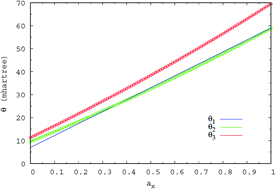TAO-DFT fictitious temperature made simple†
Abstract
Over the past few years, thermally-assisted-occupation density functional theory (TAO-DFT) [J.-D. Chai, J. Chem. Phys., 2012, 136, 154104] has been proved to be an efficient electronic structure method for investigating the ground-state properties of large electronic systems with strong static correlation effects. In TAO-DFT, the strength of static correlation in an electronic system at zero temperature is closely related to the so-called fictitious temperature (i.e., the temperature of the corresponding noninteracting reference system). In this work, we propose a simple model to define the optimal system-independent fictitious temperature of a given energy functional in TAO-DFT. Besides, we employ this model to determine the optimal system-independent fictitious temperature of a global hybrid functional in TAO-DFT as a function of the fraction of exact exchange. In addition, we adopt TAO-DFT with various global hybrid functionals and system-independent fictitious temperatures to explore the ground-state properties of several electronic systems with strong static correlation effects, such as the linear acenes and cyclic carbon chains. Furthermore, we discuss the role of exact exchange and an optimal system-independent fictitious temperature in TAO-DFT. Owing to the much reduced self-interaction error, TAO-DFT with exact exchange and an optimal system-independent fictitious temperature can accurately predict the radical character and bond length alternation of cyclic carbon chains (with even number of carbon atoms), which are challenging problems for traditional electronic structure methods.



 Please wait while we load your content...
Please wait while we load your content...